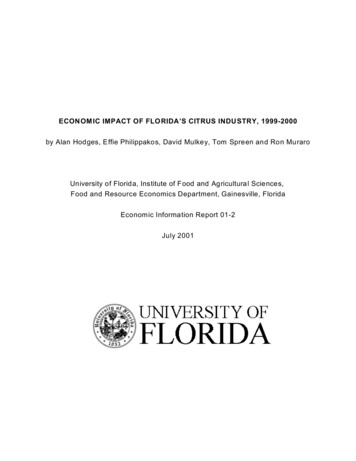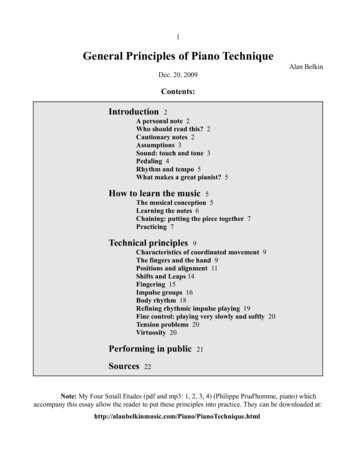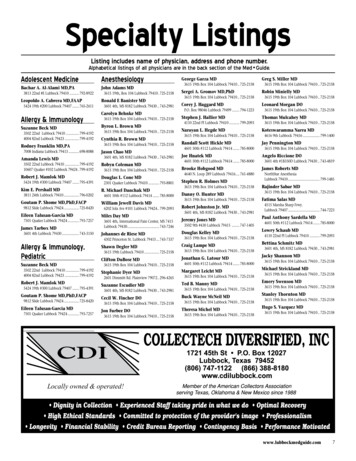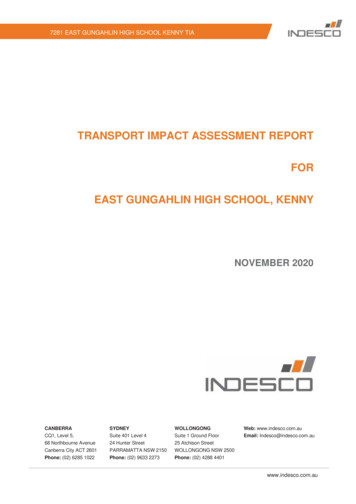
Transcription
ECONOMIC IMPACT OF FLORIDA’S CITRUS INDUSTRY, 1999-2000by Alan Hodges, Effie Philippakos, David Mulkey, Tom Spreen and Ron MuraroUniversity of Florida, Institute of Food and Agricultural Sciences,Food and Resource Economics Department, Gainesville, FloridaEconomic Information Report 01-2July 2001
Tab le of Co ntentsAbstract . 3Acknowledgm ents . 3Structure of the Florida Citrus Ind ustry . 5Florida Citrus Producing Regions . 6Citrus G rowers . 7Citrus Fruit Production and Value . 8Fresh Citrus Packinghouses . 10Citru s Processing P lants . 10Econom ic Im pact Analysis . 12Discussion and Conclusions . 14References and Information Sources Cited . 15List of Tables1. Percent of Florida citrus production, by district, 1957, 1982, 1999. . 62. Bearing acreage and number of bearing citrus trees in Florida, by variety, 1999-00. . 73. Production quantity and value of Florida citrus fruit, by variety and market channel,1999-00. . 84. Prices for Florida citrus fruit, by variety and market channel, 1999-00. . 95. Fresh citrus fruit shipped by Florida packinghouses, by district and variety, 1999-00. . 106. Value of processed Florida citrus juice products, 1999-00. . 107. Value of processed Florida citrus byproducts, 1999-00. .8. Economic multipliers for the Florida citrus indu stry .9. Value of Florida citrus industry output and exports, 1999-00. .10. Economic impacts of Florida’s citrus industry, 1999-00. .11131314List of Figures1. E conomic structure of the Flo rida citrus industry. . 52. Citrus producing regions of Florida. . 63. B earing acreage and num ber of c itrus trees in Florida, 1990-91 to 1999-00. . 74. Production of Florida citrus fruit, 1990-91 to 1999-00. . 85. Value of processed Florida orange and grapefruit juice, 1990-91 to 1999-00. . 112
ECON OMIC IMPACT OF FLORIDA’S CITRUS INDUSTRY, 1999-2000by Alan H odges, Effie Philippakos, David Mulkey, Tom Spreen and Ro n MuraroUniversity of Florida, Food and Resource Economics Department, Gainesville, FloridaRevised July 30, 2001AbstractThe citrus industry in Florida has historically been an important sector of the state’s agriculturaleconomy, and remains so today. Citrus fruits, including oranges, grapefruit, tangelos, tangerines,lime s, and other specialty fruits, are the state’s largest agricultural commodity. Florida is the world’sleading producing region for g rapefru it and second only to Bra zil in orange production. T he stateproduces over 80 percent of the United States’ supply of citrus. Production of citrus in Florida hasincreased substantially over the past 10 years, as a result of large replantings following the disastrousfreezes during the m id-19 80's. In the 1999-2000 season, a total of 298 million boxes of citrus fruit we reproduced in Florida from 107 million bearing citrus trees growing on 832,000 acres. The farm-levelvalue of citrus fruit sold to packinghouses and processing plants amounted to 1.73 billion. Nearly 90percent of Florida citrus is processed into canned, chilled, and frozen concentrate juices. Totalindustry output was 4.07 billion, including 3.58 billion in sales of citrus juice and processed citrusbyproducts, and 494 m illion in sales of fresh citrus fruit. About 93 percent of Florida citrus products,valued at 3.89 billion, were shipped to domestic and international markets outside the state. Incometo the regional economy from export sales results in secondary economic impacts. These impacts ,which were evaluated with Implan, an input-output modeling and social accounting system that wasused to develop a regional economic m odel for the state of Flo rida. To tal economic im pactsassociated with the citrus industry were estimated at 9.13 billion in industry output, 4.18 billion invalue added, and 89,700 jobs. Th is included an indirect im pact of 2 .13 billion in output attributed topurchases from other industry sectors, and an induced impact 2.93 billion resulting from consumerspending of earnings by industry employees.Keywords: citrus, Florida, economic im pact, Implan, multiplier, sales, employment, valu e added, fruit,juice, oranges, grapefru it.Acknow ledgm entsFunding for this project was provided by the Florida Department of Agriculture and ConsumerServices. Assistance was provided by Robert Barber, Economist, Florida Citrus Mutual. Technicalpeer reviews of the draft manuscript were provided by Mark Brown and Jonq-Ying Lee of the FloridaDepartment of Citrus.3
Struc ture o f the Florida C itrus Ind ustryThe econom ic structure of the Florida citrus industry is illustrated in Figure 1. Florida growers producea variety of citrus fruits such as oranges, grapefruit, temples, tangerines, tangelos, limes, and lemons.The environment of Florida provides a comparative advantage for citrus production due to naturalresources such as the subtropical climate and abundant water. C itrus is m arketed either as fres h fru itor is processed into juice products. Fruit sold for th e fre sh market is hauled to packinghouses where itis graded and packe d, the n shipp ed to term inal points for distribution to re tailers s uch as grocerystores. Culled fruit not meeting grade for the fresh market is sold to processors. Citrus produced forthe processed market is transported to processing plants for ju ice extraction. Bu lk juice is m oved toconcentrate plants for e vaporation and free zing into frozen concentrate or to canning plants for retailpackaging. Bulk frozen concentrate juice is sold to plants outside Florida for reconstituting andpackaging. Florida processors also import orange juice concentrate from Brazil, Mexico, Caribbeanbasin countries, and other citrus producing states in the United States. Retail packaged citrus juiceproducts may be exported to distributors outside the state or sold to wholesalers in Florida and then toretailers for sale to consumers under a nationally advertised brand or private grocery chain label. Ascitrus products change form and move through market channels, value is added from labor, capitaland mana gement. The industry is linked to input supply businesses that provide fertilizers, chemicals,grove care services, packaging materials, transportation, etc, and labor for citrus production andprocessing is provided by Florida residents.Figure 1. Ec onom ic structure of the Flo rida citrus industry.4
Florida Citrus Producing RegionsCitrus has been produced commercially in Florida since the mid-1800's. It is produced across thesouthe rn two -thirds of the Florida peninsula, where the re is a low p robability of dam aging w inter freezeevents, from Putnam County in the north to Miami-Dade County in the south. The four major citrusproducing regions are the E ast Coast, Low er Interior, Up per Interior, and W est Coast Districts (Figure2). In 1957 citrus production was centered in the Upper Interior District, with 40 percent of total citrusproduction, fo llowed by the Lower Interior (30 %), W est Co ast (17%), and the E ast Co ast (12%, Ta ble1). By 199 9, the geographical distribution had shifted towards the L ower Interior District (61%),follow ed by the East Coast (24 %), W est Coast (8% ), and the U pper Interior (6% ). The southwardmigration of citrus production was a response to a series of freezes in the north central region of thestate in the 1980s.Table 1. Percent of Florida citrus production,by district, 1957, 1982, 1999.District19571982East Coast12Upper Interior40Lower Interior30W est Coast17Sources: Jackson et al, 1989,Agricultural Statistics Service.Fig ure 2. Citrus producing regions of Florida .526263711Florida1999246618
Citrus Gro w ersThe number of citrus producers in Florida has remained fairly stable over the past 14 years, increasingslightly (1%) between 1987 and 1992, then declining by 6 percent to 7,676 farms in 1997 (Census ofAgriculture). W hile the number of citrus producers declined, bearing and non-bearing citrus acreageper farm increased from 90 to 125 acres between 1987 and 1997. Production capacity of citrusgrowers in Florida increased steadily over the past 10 years, reaching 832 thousand acres of bearinggroves and 97 million bearing trees in 1999-00 (Figure 3). Oranges accounted for 81 percent of thetotal population of citrus trees, followed by grapefruit (12%), tangerines (4%), tangelos (1%), temples,lime s, lemons and K-e arly citrus (Table 2).Table 2. Bearing acreage and number of bearing citrustrees in Florida, by variety, 1999-00.Va rietyAcreage (1000) Trees (1000)Oranges66687,200Grapefru 6687Lim es, Lemons, K-early3482Total All Varieties83297,381Source: Fla. Agric. Statistics Service, Commercial Citrus Inventory,2000Fig ure 3. Be aring acreage and number of c itrus trees in Florida, 1990-91 to 1999-00.Source: Florida Agricultural Statistics Service.6
Citrus Fruit Production and ValueProduction of Florida citrus fruit followed an upward trend between 1990 and 2000, increasing by 46percent, to 298 million boxes (Figure 4). Oranges and grapefruit were the top citrus comm odities,representing 78 percent and 18 percent of the total citrus boxes produced, respectively, in the 1999-00season (Table 3). One box of citrus fruit is equivalent to 90 pounds in the case of oranges, 85 poundsfor grapefruit, and 95 pounds for tangerines. Production of oranges and tangerines has increasedsubstantially du ring the last ten years. A bout 89 percent of a ll citrus was sold for juice processing while11 percent was sold as fresh fruit. For the top two citrus varieties, 96 percent of oranges and 66percent of gra pefruit w ent to the processed m arket.Figure 4. Production of Florida citrus fruit, 1990-91 to 1999-00.Table 3. Production quantity and value of Florida citrus fruit, by variety andmarket channel,1999-00.Quantity (1000 Boxes)Va rietyFreshProcessedOranges9,395223,605Grapefru it18,19135,209Temples4401,510Value ( 42,595264,3835.513.31,437.1Source: Florida Agricultural Statistics Service. *Value calculated from packinghouse doorprice multiplied by production quantity for each variety and market channel.7
The value of citrus fruit received by packinghouses and processing plants totaled 1.73 billion for the1999-00 season, with oranges accounting for th e largest share of value (78%), followed by grapefruit(18%), tangerines (2%), and tangelos and temples (1% combined, Table 3). Approximately 83 percentof this value represented citrus sold for processing. Costs for harvesting and hauling fruit from grovesto the packinghouse or processing plant averaged 1.84 per box, and were consistent across all citrusvarieties.Prices quoted for citrus fruit at different points in the marketing chain reflect the costs incurred as freshcitrus fruit is picked, hauled, and packed. Fruit produced for the fresh market consistently commandedhigher prices than fruit intended for processing. Prices for fresh market fruit shipped in 1999-00ranged fro m a high of 22.30 per box for tangerines to 15.00 per box for o ranges and tem ples (T able4).Table 4. Prices for Florida citrus fruit, by variety and marketchannel, 1999-00.Fresh,Va rietyOrangesGrapefru itTangelosTangerinesTemplesK-E arlyFre sh,1Packed( /box)15.0016.6015.8022.3015.0015.60received( /box)7.628.618.2013.607.808.00Processed,2received 2( /box)5.535.003.795.113.772.82Source: National Agricultural Statistics Service, Agricultural Prices.Free-on-board value, includes value added to fruit at packing houses.2Packing-house door value, reflects value of the fruit delivered to a packinghouse or processing plant.18
Fresh Citrus PackinghousesFresh citrus fruit is sorted and packed for shipment at packinghouses. During the 1999-00 season,there were 108 citrus packinghouses in Florida, with 54 firm s located in the E ast Coast District, 15 inthe Upper Interior, 29 in the Lower Interior, and 10 firms in the W est Coast District. The majority ofcitrus fruit was packed in the East Coast District (55%) followed by the Lower Interior (30%), UpperInterior (14%), and the W est Coast District (1%, Table 5). Grapefruit was the most important freshcitrus variety, representing 59 percent of all fresh fruit packed, followed by oranges (25%), tangerines(15%), and tangelos (2%). About three quarters of the packinghouse firms were located in the EastCoast and Lower Interior Districts, which produce 95 percent of Florida’s grapefruit. The packing costfor fresh fruit was 7.75 per box, reflecting an average mark-up in value of 89 percent above the valueas receive d at the packinghouse door (Table 4).Table 5. Fresh citrus fruit shipped by Florida packinghouses, by district and variety, 1999-00.DistrictGrapefru itOrangesTangelosTangerinesTotal1000 boxesEast Coast53,2727,2039042,76064,140Lower Interior8,89115,3948739,61434,773Upper Interior5,4465,9013594,36916,075W est Coast24270316561,016Source: Florida Department of Agriculture and Consumer Services, Division of Fruit and Vegetables, WinterHaven, Florida.Citrus Processing PlantsThere are presently 52 citrus processing plants in the state of Flo rida. Th ese plants collective lyprocessed 264 million boxes of fruit in 1999-2000. Citrus processors produce fruit juices, includingfrozen concentrate, chilled, and canned juices. Juice products shipped by Florida processors in 199900 were valued at 3.5 billion. Orange juice, including juice made from tangerines and temples, wasvalued at 3.1 billion or 91 percent of the total, while grapefruit juice was valued at 326 million (9%,Table 6). Chilled juices accounted for 58 percent of the value of all juice products, followed by frozenconcentrated juice (40%), and canned juice (2%). Between 1990-91 and 1999-00, the real (inflationadjusted) value of o range and grapefru it juice s increased by 46 percent and 60 percent, respective ly(Figure 5). T his was due to growth in value of froze n concentrate and chilled juice products, whilevalue of canned juices declined.Table 6. Value of processed Florida citrus juice products, 1999-00.OrangeGrapefru itAll CitrusPro ductJuiceJuiceJuicemillion dollarsFrozen d63770Total All Juice P roducts3,1273263,453Source: Florida Citrus Mutual.9
Fig ure 5. Value of processed Florida orange and grapefruit juice, 1990-91 to 1999-00.199 9 D ollarsSo urce : Florid a C itrus M utua l.Citru s processing plants also produce several im portant byproducts, including citrus pulp and meal,molasses, and the essential oil d-limonene. Pulp, meal and molasses are marketed as a cattle feedsupplem ent. D-limo nene is used fo r a variety of chemical products such as cleaners, disinfectants,flavors and fragrances. During the 1999-00 season Florida citrus processors produced 1,370,000 tonsof pulp and meal, 31 ,00 0 to ns of molasses, an d 35 th ousand pounds of D-limonene. C olle ctively,these byproducts were valued at 123 million, with pulp and meal accounting for nearly 88 million(71%), followed by d-lim onene at 33 million (27%), and molasses at 2 m illion (2% , Table 7 ).Table 7. Value of processed Florida citrus byproducts, 1999-00.million dollars ( )*Citrus Pulp and Meal87.9D-Limonene33.1Molasses2.1Total123.1Source: Florida Citrus Processors Association*Value estimated from production quantities multiplied by corresponding averageannual prices reported in Feeds tuffs and Chemical Market Reporter.10
Ec on om ic Im pact AnalysisAn export-based industry such as the Florida citrus industry impacts the regional economy threeprimary ways, referred to as direct, indirect and induced effects (Miller and Blair, 1985). As directeffects, citrus growers, packinghouses and processors generate output and value added, and provideemployment and wages to employees. As indirect effects the industry supports other regionalenterprises through inter-industry purchases of inputs to the production process. As induced effects,personal consumption expenditures by employees in bo th the citrus indu stry and com plem entarybusinesses further stim ulate the local econom y. Th e total economic im pacts are the sum of th e direct,indirect and induced effects. Since exported goods introduce new money to Florida, commodity salesoutside of the state are associated with greater economic im pacts than sales to Florida consum ers.Also, inputs obtained from Florida firms rather than imported from outside of Florida are associatedwith greater economic impacts because money is retained and circulated within the state.Th e tota l economic impacts of the citrus indu stry in Florida were estimated with economic multipliersdeveloped using the IMPLAN PRO software and associated databases for Florida licensed fromMinnesota Implan Group (MIG, Inc.). The IMPLAN system enables construction of re gional inputoutput models for any county, group of counties, or state in the United States based on a combinationof county level and national econom ic data. Industries are classified in 528 sectors, corre sponding tothe fou r-digit Standard Industrial Classification (S IC) System . Mu ltipliers for each sector are availablefor the economic indicators of output, value added, employment, employee compensation, laborincome, other proprietary income and indirect business taxes. Total economic impacts were computedby applying the econom ic m ultipliers as follows:Total impa ct Y * M D(Output, VA, Emp) E * M I(Outp ut, VA , Em p) E * M IN(Output, VA, Emp)where, E is export sales (all sales outside Florida), Y is value of ou tput,M D(O utpu t, VA, E mp ) is the direct effects m ultiplier for output, valu e-added, em ployment,M I(Outp ut, VA , Em p) is the indirect effects multiplier for output, valu e-added, em ployment,M IN(O utpu t, VA, E mp ) is the induced effects multiplier for output, valu e-added, em ployment.In the IMPLAN system, citrus growers are classified under the ‘fruits’ sector that includes berry crops,grapes, and deciduous tree fruits, in addition to citrus fruits. Citru s processors are aggregated withprocessors of frozen fruits and vegetables, frozen fruit juices and concentrates, quick frozen andcoldpack fruits and vegetables, and dried citrus pulp. The fruits sector of the Florida IMPLAN m odelwas customized to reflect the specific characteristics of fresh citrus production based on operatingbudgets for Florida citrus growers (Muraro et al., 2000). Default information for the processing sectorwas not m odified due to lack of da ta on operating expenditures. Econom ic m ultipliers used for th isanalysis are shown in Table 8. For example, the indirect value added multiplier for the fruits sector(0.321) indicates that for e ach dollar of in dustry output sold to final dem and .321 was generated invalue added.11
Table 8. Ec onom ic m ultip liers for the Flo rida citrus industry.DirectFruitsIndirect InducedOutput ( / )1.0000.5700.7672.3371.0000.5580.7702.328Value Adde d (pe r ou 036561121Em ployment (jobs perm illion output)TotalFrozen Fruits, Juices and VegetablesDirectIndirect InducedTotalSource: M IG, 1998 , Implan data for Florida.The total value of ou tput of fresh citrus fruit, citrus juice, and processed citrus by-products was 4.1billion during the 1999-00 season (Table 9). The value of exports (sales outside Florida) of citrusproducts was 3.81 billion. Ninety seven percent of fresh citrus, 94 percent of citrus juice products,and 81 percent of citrus by-products were exported outside the state of Florida. The value of citrusjuice exports was calculated by deducting the estimated Florida consumption from the total value ofoutput. It was assumed that national per capita consumption of citrus juices, and prices for citrusjuices applied in Florida. The proportion of d-limonene and molasses exported from Florida wasassumed to be consistent with the proportion of citrus pulp and meal exported.Table 9. Value of Florida citrus industry output and exports, 1999-00.OutputExports( million)( million)Fresh C itrus F ruitProces sed Citrus Juice an d Byprodu ctsTotal493 .6476 .63,575.74,069.33,332.73,809.3Source: Florida Department of Agriculture and Consumer Services, National AgriculturalStatistics Service, Florida Department of Citrus, Florida Citrus Mutual.Total economic impacts of the state’s citrus industry were estimated at 9.1 billion in output, 89,700jobs, and 4.2 billion in value-added (Table 10). The total value added, includes wages earned byindustry employees, income to business owners, and business taxes paid. This represents the neteconomic contribution by the industry to the state economy. The total economic impacts of processedcitrus juice and byproducts included 8.0 billion w orth of o utput, over 72,000 jobs and 3.7 billion invalue added. Total economic impacts of fresh citrus fruit included 1.1 billion in output, over 17,000jobs, and 509 million in value added. Note that in order to avoid double-counting of impacts, theimpact estim ates for the processed citrus sector represent the fa rm production activities of citrus fru itutilized for juice, while the impact estimates for the fresh fruit sector represent only the fruit sold forfresh consumption. Direct impacts accounted for 45 percent of output, 26 percent of employment, and25 percent of value added im pacts for th e industry. Indirect im pacts am ounting to 2.13 billion inoutput, represented economic activity stimulated in other business sectors that furnish inputs to citrusproduction and processing, and were 23 to 30 percent of total economic impacts. Induced impacts,amounting to 2.93 billion in output, represent additional personal consumption expenditures resultingfrom employee earnings. The induced effects were 32 percent of total output impacts, 45 percent oftotal em ployment impacts, and 46 percent of to tal va lue added im pacts. Th us, the total econom icimpacts were over twice as great as the direct impacts of industry sales.12
Table 10. Economic impacts of Florida’s citrus industry, ,130.7Pro cessed Citru s Juice and Byproducts3,575.71,859.02,567.48,002.1Citrus Industry ,471Pro cessed Citru s Juice and Byproducts16,59520,69935,01272,306Citrus Industry Total22,88326,88540,01089,778Output ( million)Fre sh Citru s FruitEmployment (Jobs)Fre sh Citru s FruitValue Added ( million)Fre sh Citru s Fruit115.0153.2241.2509.4Pro cessed Citru s Juice and Byproducts925.8.01,056.01,686.33,668.2Citrus Industry Total1,040.91,209.31,927.54,177.7Discussion and ConclusionsThis study dem onstrates that the Florida citrus industry has a very large impact on the state’seconomy, estimated at 9.13 billion in output and 4.18 billion in value added in the 1999-2000season. The magnitude of total economic impacts was over twice as large as the direct impact ofindustry sales, as a result of the high proportion of total output that is shipped outside the state, whichbring s new money into the region al econom y and stimulates additional economic activity. Industryproduction and value have increased significantly over the past ten years. The information used forthis analysis was the most recent a vailab le, a nd appears to have been a normal year for the industry,consistent with long term trends.The economic impacts of the Florida citrus industry estimated in this study were significantly largerthan indicated by previous studies (e.g. Benioudakis and Brown, 2000), due to continued growth in theindustry, and use of an updated regional economic model. The Implan multipliers used in this analysismore fully accounted for the indirect and induced effects than previous models, particularly the impactof personal consumption expenditures. Multipliers used for the fresh fruit sector were based onproduction expenses for Florida citrus fruit production. A limitation of this study is that information onexpenditures by Florida citrus processors was not available. So, the multipliers used for the processingsector reflected typica l interind ustry expe nditures for fruit juice and frozen vegetable processing firm sthroughout the U S. T o the degree that Florida citrus processing firm s differ from national averages inthe pattern of e xpenditures, the results of th is analysis m ay va ry.13
References and Information Sources CitedAndre, Michel. A comparative analysis of the technical efficiency of Florida and California fresh citrusgrowers. Thesis submitted to the Food and Resource Economics Department, University ofFlorida, Gainesville, FL 1996.Benioudakis, Nikolaos and Mark Brown. The economic impact of the Florida citrus industry onFlorida’s economy. Staff Report 2000-1. Florida Department of Citrus, Gainesville, FL, May2000.Florida A gricultural Statistics Service (FASS ), Citrus Summary 19 99-00. Tallahasse e, Florida, Jan uary2001.Florida Agricultural Statistics Service (FASS). Commercial Citrus Inventory 2000. Tallahassee,Florida, December 2000.Florida Agricultural Statistics Service (FASS). Farm Cash Receipts and Expenditures. Tallahassee,Florida, August 2000.Florida Citrus Processors Association. Statistical Summary 1999-00 Season. Winter Haven, Florida.Florida Department of Agriculture and Consumer Services, Division of Fruit and Vegetables, WinterHaven, Florida.Flo rida D epartment of Citrus. F lorida citrus: cultivating an /news13.htm. Lakeland, FL.Florida Department of Citrus, Florida fresh citrus shipments 1999-00 annual report, Economic andMa rket Re search D epartm ent, Gainesville, FL. Septem ber 2000.Jackson, L.K., R .M. D avis, J.M. B ulger, G .F. F airchild, R.P . Mu raro , and D .P.H . Tu cker. Introduction tothe Florida citrus industry – its production, harvesting and marketing practices. Staff Paper 41,University of Florida, Institute of Food and Agricultural Service, Florida Cooperative ExtensionService, Gainesville, FL, 1989.Miller, R.E. and P.D . Blair, 1985. Input-Output Analysis: Foundations and Extensions. Pre ntice-H all,Englewood Cliffs, New Jersey, 464 p.Minnesota Implan Group (MIG), 2001. Implan economic impact and social accounting software, anddata fo r Florida. Stillwater, MN .Muraro, Ronald P. and Max Still. Budgeting cost and returns for Central Florida citrus production,1999-00. Economic Information R eport EI 00-6 , University of Florida, Gainesville, FL,December 2000.Muraro, Ronald P., John W . Hebb and Ed W . Stover. Budgeting cost and returns for Indian Rivercitrus production, 1999-00. Economic Information R eport EI 00-8 , University of Florida,Gainesville, FL, December 2000.Muraro, Ronald P., Fritz M. Roka, and Robert E. Rouse. Budgeting cost and returns for southwestFlorida citrus production, 1999-00. Economic Information R eport EI 00-7 , University of Florida,Gainesville, FL, December 2000.National Agricultural Statistics Service (NASS), United States Department of Agriculture. AgriculturalPrices. W ashington, DC, 2000.United States Census Bureau, W ashington, DC, 2000. United States Department of Agriculture. 1997Census of Agriculture, Vol. 1 Geographic Area Series, Florida, AC-97-A-9. W ashington, DC.14
5 Florida Citrus Producing Regions Citrus has been produc ed commercial ly in Florida since the mid-1800's. It is produced across the southern two-thirds of the Florida peninsula, w










